Choosing the right guitar pick might seem like a minor detail, but it can significantly impact your playing experience and tone. Like many guitarists, you’ve probably experimented with a drawerful of different picks, searching for that elusive perfect feel and sound. From thin and flexible to thick and rigid, the options are endless. But with so many choices, where do you even begin? This guide dives deep into the world of guitar picks, exploring materials, shapes, sizes, and more, to help you discover your Recommended Guitar Picks and elevate your playing.
 Rock Stock What’s The Best Guitar Pick
Rock Stock What’s The Best Guitar Pick
Why Are Guitarists So Particular About Their Picks?
It’s true, guitarists can be meticulous about their gear. Strings, pedals, amps – every component is scrutinized in the quest for the perfect sound. Guitar picks are no exception. Think of a pick as an extension of your hand, the direct link between you and your guitar strings. It’s responsible for initiating the vibration that creates your tone. A pick influences not just the sound, but also your playing technique and comfort. Experimentation is key because what feels and sounds ideal is highly personal. Just like you might have a collection of overdrive pedals, each offering a slightly different flavor, exploring various guitar picks opens up a spectrum of sonic possibilities. And let’s be honest, the relatively low cost of picks makes it easy and fun to amass a collection in the pursuit of tonal nirvana.
Decoding Guitar Pick Materials
Guitar picks are crafted from a surprisingly wide array of materials, each contributing unique sonic and tactile qualities. Here’s a rundown of some common and less common materials:
Celluloid
Celluloid is a classic material, often associated with vintage “tortoise shell” picks. Known for its flexibility and warm, bright tone, celluloid is a popular choice for players seeking a traditional feel and sound. It tends to wear down relatively quickly compared to more modern materials, which some players appreciate for its evolving tone as the pick ages.
Nylon
Nylon picks, such as the widely used Dunlop Standard series, are prized for their flexibility and textured grip. The inherent grip of nylon makes these picks a favorite for players who struggle with slippage, particularly in fast-paced or sweaty playing situations. Nylon typically produces a softer, warmer tone compared to celluloid.
Acetal (Tortex)
Acetal, often recognized under the brand name Tortex by Dunlop, is a synthetic polymer renowned for its durability and balanced tonal characteristics. Tortex picks offer a matte finish, providing excellent grip even without added текстурирование. The material is known for its resilience and long lifespan, making it a cost-effective and reliable option. Many players appreciate the “powdery” grip enhancer often found on Tortex picks for added security.
Ultem
Ultem is a less common but highly regarded material, known for its exceptional stiffness and bright, articulate tone. Ultem picks are incredibly durable and resistant to wear, maintaining their shape and tone for extended periods. Despite their stiffness, they can produce a surprisingly smooth attack, making them suitable for precise and fast playing styles.
Acrylic
Acrylic picks are distinguished by their clear appearance, density, and durability. These picks can be manufactured in a wide range of colors and often feature textured grips to compensate for the naturally slick surface of acrylic. Acrylic picks generally produce a bright, clear tone with a defined attack, favored by players seeking clarity and articulation.
Exploring Exotic and Unique Guitar Picks
Beyond the standard materials, the world of guitar picks extends to more specialized and unique options, catering to specific playing needs and preferences:
Purple Plectrums
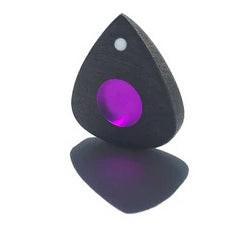 Purple plectrums What’s The Best Guitar Pick? Rock Stock Pedals blog
Purple plectrums What’s The Best Guitar Pick? Rock Stock Pedals blog
Purple Plectrums stand out due to their extreme thickness, ranging from 6mm to a massive 9mm. These picks are designed for ergonomic comfort, reducing hand fatigue during long playing sessions. The significant thickness provides a substantial feel and can produce a very full, powerful tone. Despite their size, they often feature a pointed tip for precise picking.
Dragon’s Heart Guitar Picks
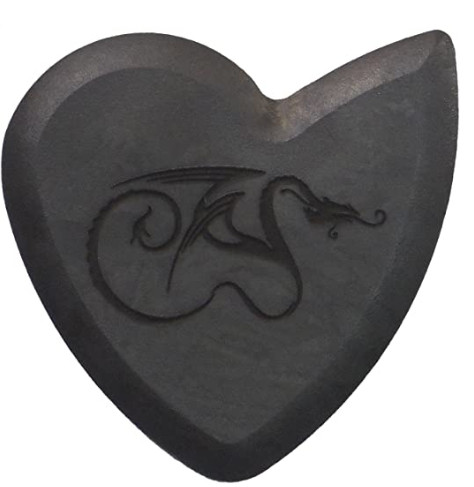 dragon
dragon
Dragon’s Heart picks are known for their unique trident shape and exceptional durability. Constructed from materials like graphite and kevlar, they boast an incredibly long lifespan, with some models claiming up to 1000 hours of playing time. The trident design offers three distinct playing edges – a sharp point and two rounded variations – providing tonal versatility from a single pick.
Chibson Jumbo Guitar Pick
 chibson jumbo guitar pick What’s The Best Guitar Pick? Rock Stock Pedals blog
chibson jumbo guitar pick What’s The Best Guitar Pick? Rock Stock Pedals blog
The Chibson Jumbo Guitar Pick is more of a novelty item, emphasizing the sheer variety in pick sizes. Its oversized nature is primarily for humorous effect, but it highlights the spectrum of pick dimensions available, from miniature jazz picks to extra-large triangle picks.
Understanding Guitar Pick Thickness and Sizes
Pick thickness is a crucial factor influencing both tone and playability. Picks are generally categorized into four thickness ranges:
-
Thin (0.40mm – 0.60mm): Thin picks are highly flexible and produce a brighter, less bass-heavy tone. They are popular for strumming acoustic guitars, creating a light, airy sound that cuts through the mix. However, they can lack body and definition for lead playing or heavier styles.
-
Medium (0.60mm – 0.80mm): Medium picks offer a balance of flexibility and stiffness, providing a versatile option for both strumming and lead work. They deliver a fuller tone than thin picks with a good balance of brightness and body. Many players find medium picks to be a comfortable all-around choice.
-
Heavy (0.80mm – 1.20mm): Heavy picks are significantly stiffer, producing a thicker, more powerful tone with increased bass response. They are favored for genres like rock and metal, where a strong attack and defined notes are desired. Heavy picks offer more control for fast picking and articulate lead lines.
-
Extra Heavy (1.20mm+): Extra heavy picks are the stiffest and thickest, providing maximum power, control, and bass response. They are often preferred by players who demand extreme precision and a very full, dark tone, particularly in genres like jazz and heavy metal. However, they can be less forgiving and require more control.
The thickness of a pick directly affects how it interacts with the strings. Thinner picks flex more, resulting in a brighter, less sustained tone, while thicker picks move the strings more directly, producing a fuller, more sustained sound. Experimenting with different thicknesses is crucial to finding what works best for your playing style and desired tone. For example, a thin pick might be ideal for delicate acoustic strumming, while a thick pick would be better suited for aggressive metal riffs.
Exploring Different Guitar Pick Shapes
Beyond material and thickness, pick shape also plays a significant role in feel and tone. Here are some common pick shapes:
Classic/Standard Pick
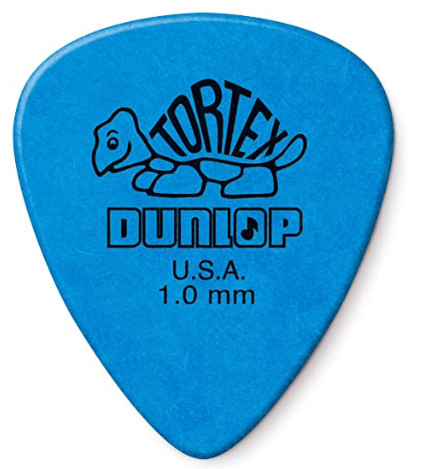 tortex guitar pick What’s The Best Guitar Pick? Rock Stock Pedals blog
tortex guitar pick What’s The Best Guitar Pick? Rock Stock Pedals blog
Alt text: A standard shaped Tortex guitar pick in green, demonstrating the classic, familiar shape that is widely used by guitarists across genres for its versatility and comfortable grip.
The classic or standard pick shape is the most common and versatile. Its rounded tip and comfortable size make it suitable for a wide range of playing styles, from strumming chords to playing lead lines. The familiar shape fits comfortably between the thumb and index finger, providing a balanced feel and control.
Jazz Pick
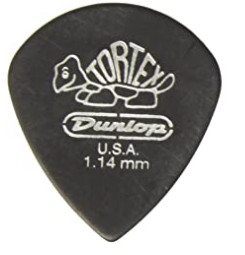 tortex guitr pick dunlop What’s The Best Guitar Pick? Rock Stock Pedals blog
tortex guitr pick dunlop What’s The Best Guitar Pick? Rock Stock Pedals blog
Alt text: A Dunlop Tortex Jazz guitar pick in red, highlighting its smaller size and sharper, pointed tip designed for precision and speed, favored by jazz and metal guitarists.
Jazz picks are characterized by their smaller size and sharper, more pointed tip. Despite their name, they are popular not only among jazz players but also metal and shred guitarists who prioritize accuracy and speed. The smaller size offers increased control and precision, while the pointed tip provides a focused attack and articulate tone, ideal for fast, intricate playing.
Tri-Tip/Triangle Picks
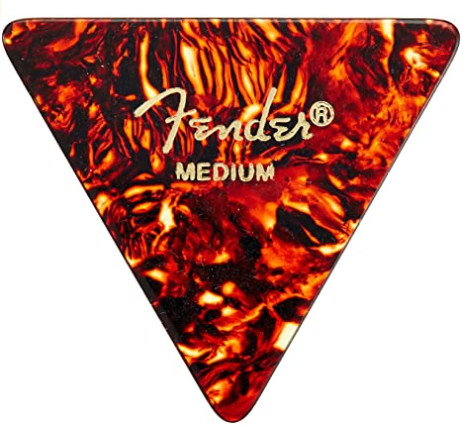 fender medium guitar pick What’s The Best Guitar Pick? Rock Stock Pedals blog
fender medium guitar pick What’s The Best Guitar Pick? Rock Stock Pedals blog
Alt text: A Fender triangle-shaped guitar pick in white, showing its larger size and rounded edges which offer a comfortable grip and multiple playing edges for varied tones.
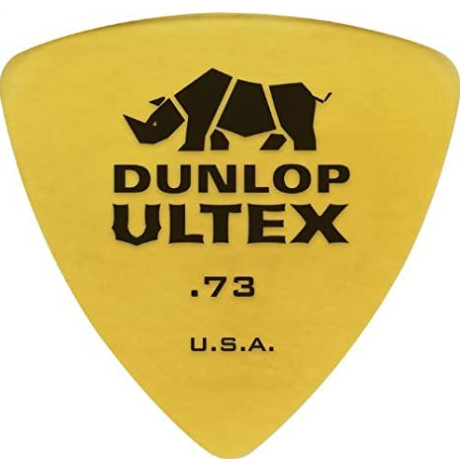 dunlop ultex guitar pick What’s The Best Guitar Pick? Rock Stock Pedals blog
dunlop ultex guitar pick What’s The Best Guitar Pick? Rock Stock Pedals blog
Alt text: A Dunlop Ultex triangle guitar pick in amber, illustrating a more rounded version of the triangle shape, still providing a larger gripping surface and versatile playing edges.
Triangle picks, also known as tri-tip picks, are larger than standard picks, offering a more substantial gripping surface. This can be particularly beneficial for players with larger hands or those seeking a more secure grip. Triangle picks often feature three identical corners, extending their lifespan as you can rotate to a fresh edge when one wears down. They are available in both pointed and rounded versions, offering tonal variations.
How to Choose Your Recommended Guitar Picks
Finding your ideal guitar pick is a journey of experimentation. There’s no single “best” pick for everyone, as personal preference plays a huge role. However, considering your playing style, genre, and desired tone can narrow down the options. Here are some recommendations based on common playing scenarios:
Recommended Guitar Picks for Shredding and Lead Guitar
For fast, precise lead playing, particularly in genres like rock and metal, a firmer pick with a sharper point is generally recommended. Picks in the heavy to extra-heavy thickness range (0.80mm – 1.20mm+) provide the necessary stiffness and control for articulate lead lines and fast picking techniques. Jazz picks or standard-shaped picks with a defined point are popular choices for shredders.
Recommended Guitar Picks for Acoustic Guitar Strumming
For acoustic guitar strumming, the best pick depends on your strumming intensity and desired tone. Lighter strumming often benefits from thinner picks (0.40mm – 0.73mm), which produce a brighter, more delicate tone. Medium strumming styles can utilize medium picks (0.60mm – 0.80mm) for a balanced tone, while aggressive strumming might require heavier picks (0.80mm+) to prevent excessive flex and maintain tonal clarity. Experimenting within the thin to medium range is a good starting point for acoustic players.
Recommended Guitar Picks for Joint Pain or Arthritis
Guitarists experiencing joint pain or arthritis should prioritize ergonomic comfort. Larger picks, such as triangle picks or specialized ergonomic picks like Purple Plectrums or Dragon’s Heart picks, can be easier to grip and require less pressure, reducing hand strain. Thicker picks, in general, can also be less fatiguing as they require less force to produce a strong sound.
Recommended Guitar Picks for Best Grip
If you struggle with dropping picks, textured grip picks are highly recommended. Nylon picks, Tortex picks with their matte finish and optional grip enhancers, and picks with added текстурирование provide a more secure hold, even with sweaty hands. Larger pick shapes can also improve grip due to the increased surface area.
Experimentation is Key: Try a Variety Pack of Guitar Picks
The best way to discover your recommended guitar picks is to try a wide variety. Guitar picks are inexpensive, making it easy to build a collection and experiment. Consider purchasing a variety pack that includes different materials, thicknesses, and shapes. Spend time playing with each pick, paying attention to how it feels in your hand, how it affects your tone, and how it responds to your playing style. Give each pick a fair trial period, as it may take some time to adjust to a new feel. You might be surprised at what you discover!
And remember, finding the “best” guitar pick is a personal journey. What works perfectly for one guitarist might not be ideal for another. Embrace the experimentation process, and enjoy the tonal exploration that different guitar picks offer.
 tenor-1
tenor-1
